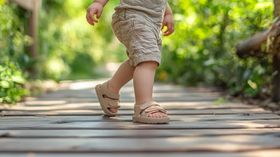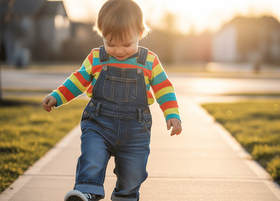Toddler Shoes: 3 Myths & Facts You Should Know Before Buying
Updated January 4, 2026

There seem to be conflicting views online when it comes to choosing the perfect pair of toddler shoes. Even podiatrists and foot development experts give varied advice, such as “wear supportive kids’ shoes” or “go barefoot instead.”
No worries though, experts do agree on some key points. Setting aside the grey areas, (reserve those for your pediatrician to answer), here are surefire tips to go by when scouting for boys’, girls’, or unisex kids’ shoes.
Myth #1: Flat feet in children should be corrected with special toddler shoes
Fact: Children are born with flat (and chubby) feet. Somewhere between 9 to 12 months, kids begin to walk and explore different kinds of surfaces. Their flat soles gradually form arches and gain bone and muscle strength. This happens until they are around 3 or 4, and in some cases until they’re 6. It really depends. But since bones are not yet fully formed, feet are easily impacted by the kind of footwear they use.
However, don’t be alarmed when a shoe salesman tells you that your 2-year-old has flat feet. It’s the most normal thing in the world.
Takeaway: Don’t use corrective girls’ sandals or boys’ sneakers unless your child was diagnosed by a doctor or foot expert, and was prescribed with such a form of treatment. However, anatomic toddler shoes are prefect for your flatfooted little one; these are not the same as “prescription” footwear.
Myth #2: Pre-walker feet depend on quality kids’ shoes for proper development
Fact: Toddler feet develop on their own as your boy or girl explores his or her environment, but quality toddler shoes are truly crucial when he finally needs to put on a pair of pre-walker sandals or unisex sneakers.
Feet best experience their environment when bare. They learn to balance and develop form and strength as a result of the sensory experience provided by walking barefoot. However, since bones on toddler feet are still in the process of being formed, you want to avoid footwear that molds her feet the wrong way when she finally needs to put on a pair of mary janes.
Takeaway: Avoid cheaply manufactured kids’ shoes that compromise shape and function for the sake of style and fashion. For example, steer clear of toddler shoes with extra pointed toe box that squeezes feet into restricted positions. Avoid pre-walker shoes with forepart (upper part) that flares inward (when it should simply be straight). Avoid girls’ high heels as well. Heels should be minimal and functional, not for fashion statement.
Inasmuch as we hope that the environment is always safe to explore barefoot, there are times when your child needs to wear footwear, either for protective or socialising purposes (going to a party maybe)?
Takeaway: When it’s time to wear toddler sandals or kids’ shoes, go for quality footwear that are especially designed for kids’ developing feet. A perfect example of such especially designed shoes are “anatomic” or “orthopedic” children’s footwear.
Myth #3: Orthopedic toddler shoes are only for abnormal feet
Fact: Non-corrective orthopedic toddler shoes are for every toddler.
Not all orthopedic children’s shoes are “corrective” or “prescriptive.” First Walkers orthopedic toddler shoes simply address the unique needs of newly developing feet of each young boy and girl. These are, feet:
- have undeveloped arches, aka are flat
- have unformed, delicate bones or cartilage
- sweat a lot, and
- grow fast
The awesome thing about orthopedic toddler shoes is that they are uniquely designed for developing, delicate, sweaty, and growing feet. Anatomic kids’ shoes provide the right amount of support, breathability, and flexibility.
First Walkers kids’ shoes have insoles that cushion feet with soft support. They are made of comfortable, breathable, and antimicrobial materials.
Elastic outsoles provide flexibility and lessen impact on delicate feet. Air valves are also present for added breathability.
All have leather and nubuck uppers with hook-and-loop straps, making them breathable, adjustable, great fitting, and durable.
If you have further questions about your child’s feet development, of course it is best to bring him to a medical expert.
Toddler years are formative for every child, not just mentally and socially, but also physically. Avoid shoes with questionable quality. Check kids’ shoes for right design before putting them on your little one’s feet. And encourage your toddler to practice walking barefoot. Otherwise, make him wear quality, comfy toddler shoes or sandals.






